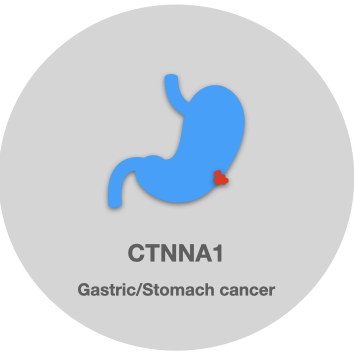Summary of evidence associating CTNNA1 and Stomach/Gastric Cancer

Introduction
Hereditary diffuse gastric cancer syndrome (HDGC) is often linked with a heightened risk of diffuse gastric cancer and lobular breast cancer, usually resulting from germline pathogenic variants in the CDH1 gene. However, many families who meet the HDGC criteria do not show detectable pathogenic CDH1 variants, leading researchers to delve deeper into the genetic intricacies of this syndrome.
One potential genetic contributor is CTNNA1 - a gene that encodes for α-E-catenin, a protein that interacts with E-cadherin. First highlighted by a 2013 exome sequencing study, subsequent research has found individuals with diffuse gastric cancer carrying truncating CTNNA1 variants. Nevertheless, a comprehensive understanding of CTNNA1's role in gastric cancer risk and its overall cancer penetrance is still in progress.
In this blog post, we guide you through the significant findings of the first large-scale analysis of CTNNA1 mutations. We aim to shed light on the prevalence and penetrance of CTNNA1 Loss-of-Function (LOF) variants and discuss how this newfound knowledge might transform clinical decision-making and risk management for individuals carrying these mutations.
| Cohort | Setup | Outcome | HGVS(es) | Citation |
|---|---|---|---|---|
| A large HDGC pedigree with no obvious mutation in CDH1 | Exome sequencing to identify new genes involved in gastric cancer | Identified a germline truncating allele of -E-catenin (CTNNA1) in two family members with invasive diffuse gastric cancer. | - | PubMed |
| Adults with gastric cancer of any histology, and with a germline DNA sample (n=51), were retrospectively selected. | Identification of germline susceptibility genes from participants with gastric cancer. Sequencing of 706 candidate genes for those without previously identified germline mutations. | 20 pathogenic or likely pathogenic variants were identified among 18 participants including one mutation in CTNNA1gene. | NM_001903.5:c.385C>T p.Arg129Ter | PubMed |
| 90 individuals (40% men; mean age, 48 years) from 40 families. | Extensive inspection of the stomach was performed by gastroscopy, taking random and/or targeted stomach biopsy specimens to identify diffuse-type gastric cancer | Signet ring cell carcinoma foci restricted to the mucosa (pT1a) were identified in 4 persons (4%) from 1 family, which afterward was diagnosed with a germline CTNNA1 mutation. | - | PubMed |
| Unexplained young and/or familial patients with GC (n=286) without a CDH1 germline mutation | Targeted next-generation sequencing approach based on single-molecule molecular inversion probes for germline variants affecting CTNNA1, MAP3K6 and MYD88 | Recurrently observed deleterious variants in CTNNA1 (n=2) and MAP3K6 (n=3), but no predicted deleterious germline variants in MYD88 | NM_001903.5(CTNNA1):c.80_81del (p.Arg27fs), NM_001903.5(CTNNA1):c.536C>T (p.Ala179Val), NM_001903.5(CTNNA1):c.618G>C (p.Gln206His), NM_001903.5(CTNNA1):c.770A>G (p.Asn257Ser), NM_001903.5(CTNNA1):c.964_988dup (p.Arg330fs), NM_001903.5(CTNNA1):c.1328dup (p.Asn443fs) | PubMed |
| Patients meeting the 2015 HDGC clinical testing criteria were included, and CDH1 and CTNNA1 sequencing | Of the 207 patients (161 families) in this study authors detected one CTNNA1 pathogenic variant in two patients. | NM_001903.5:c.1175delA p.(Asp392Valfs*13) | PubMed | |
| 151,425 individuals who underwent CTNNA1 testing at a commercial laboratory between October 2015 and July 2019 | CTNNA1 testing on multigene panel testing | CTNNA1 LOF variants are detected on MGPT with a majority of these individuals having gastric or breast cancer. The overall risk of gastric cancer for CTNNA1 LOF carriers may be lower than expected. Given the uncertain phenotype and penetrance, managing individuals with CTNNA1 LOF variants remains challenging. | NM_001903.5:c.105+1G>C, NM_001903.5:c.1078_1081del (p.Arg360Valfs8), NM_001903.5:c.1246_1294del (p.Val416Argfs14), NM_001903.5:c.1261C>T (p.Gln421), NM_001903.5:c.1330dup (p.Glu444Glyfs23), NM_001903.5:c.1390-?_1546+?del, NM_001903.5:c.1613_1617dupTGGAC (p.Arg540Trpfs18), NM_001903.5:c.1997delG (p.Gly666Alafs56), NM_001903.5:c.2023C>T (p.Gln675), NM_001903.5:c.2191C>T (p.Arg731), NM_001903.5:c.2393_2394insT (p.Glu799Argfs79), NM_001903.5:c.2443_2462dup (p.Ala822Profs4), NM_001903.5:c.2491C>T (p.Gln831), NM_001903.5:c.2621_2622delAA (p.Lys874Thrfs3), NM_001903.5:c.2621_2627 dupAACAGGA (p.Asp876Glufs4), NM_001903.5:c.2635_2636delCA (p.Gln879Aspfs4), NM_001903.5:c.392dupT (p.Leu131Phefs13), NM_001903.5:c.468+1G>A, NM_001903.5:c.926_936del (p.Leu309Hisfs2) | PubMed |
Conclusions:
The narrative of CTNNA1's role in gastric cancer is compelling and complex as we continue to decipher its subtle cues in the interplay of genetics and disease. The spotlight on CTNNA1 has unveiled a previously unrecognized layer of intricacy in our understanding of gastric cancer. Future research and case studies must continue to unravel the mysteries of CTNNA1 and other genes that could be potential game-changers in cancer genetics.